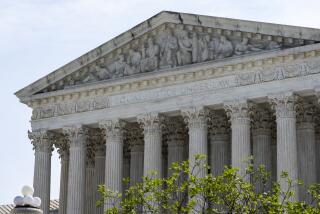Mid-’60s Project Fuels Environmental Fight
- Share via
NEW ORLEANS — A controversial project to build a hurricane barrier for New Orleans 40 years ago and an environmental lawsuit that stopped construction have moved to the center of a political battle to reform federal environmental laws.
A House panel today will examine whether New Orleans defenses against Hurricane Katrina were compromised by the suit, which resulted in an injunction in 1977. The U.S. Army Corps of Engineers dropped the project by 1986 in favor of raising levees in the city.
The hearing in Norfolk, Va., is part of an effort by conservatives to reform the National Environmental Policy Act. Under the law, environmentalists have challenged hundreds of public and private projects.
Separately, Sen. James M. Inhofe (R-Okla.), among the staunchest critics of environmentalists, has asked the Justice Department to collect information on every NEPA suit that blocked corps of engineers projects.
Amid growing efforts by conservatives to reform NEPA, the 1960s-era hurricane barrier and the environmental suit that blocked it have become a celebrated cause among conservatives in the aftermath of Hurricane Katrina.
Congress in the mid-1960s approved a massive hurricane barrier to protect New Orleans from storm surges that could inundate the city from the Gulf of Mexico. The system included a lengthy levee along the city’s eastern flank and giant floodgates that could shut off Lake Pontchartrain if a hurricane was approaching.
Conservatives have seized on the injunction that scuttled the project as an example of public safety taking a back seat to the environment. But on Friday, Sen. Barbara Boxer (D-Calif.), charged that the Justice Department was trying to “smear environmentalists” by blaming them for the federal government’s failure to shore up the Louisiana coastline.
Inhofe’s staff requested that the Justice Department compile a list of Army Corps projects that were blocked by NEPA suits. Earlier this year, Inhofe directed two national organizations that opposed a major Bush administration clean-air initiative to turn over their financial and tax records to the Senate, in part to see whether they were influenced by environmental groups.
Meanwhile, a bipartisan panel of 10 Republicans and 10 Democrats in the House is examining how to “improve” NEPA, though environmentalists say the intent of Republicans is to gut the law. NEPA was among the first major pieces of environmental legislation. It requires environmental impact statements before major public or private projects can be built.
Rep. Cathy McMorris (R-Wash.), who is chairing the task force, said the panel is concerned about the growth of litigation under the act and whether it has been used to block projects critical to public safety. McMorris said there are 1,500 active suits under NEPA.
“We are seeing more and more lawsuits tied to NEPA and the NEPA process,” said McMorris, who added that the panel is not aiming to weaken environmental protections or standards.
Douglas Kysar, a Cornell University professor of environmental law, said the Army project to build the New Orleans hurricane barrier and the suit against it have lit up the conservative cause. “This thing is hot,” Kysar said.
But, Kysar said, the project failed for a number of reasons. He noted that the objections to the project included damage to wetlands that are natural hurricane protection barriers.
Kysar also cited a General Accounting Office report in 1976, issued the year before the NEPA suit, that found the project was experiencing massive delays and cost overruns, caused largely by the inability of the Army to obtain access to rights of way and obtain the necessary land to build levees and control structures.
A close look at the project will leave egg on the faces of environmentalists and on conservatives who espouse property rights, Kysar said. Another part of the problem, he added, was that the Army Corps had to justify the cost of the barrier based on projected benefits to saving property. Under the law, it could not put a dollar figure on the value of saving human life.
Vartabedian reported from New Orleans and Schmitt from Washington.
More to Read
Sign up for Essential California
The most important California stories and recommendations in your inbox every morning.
You may occasionally receive promotional content from the Los Angeles Times.











